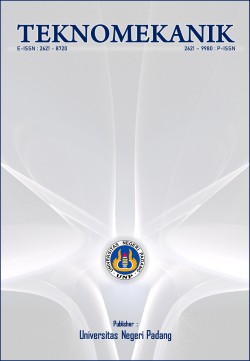Evaluation of implementation of learning practices during pandemi Covid-19 Coating And Beauty Education Study Program
DOI:
https://doi.org/10.24036/jptk.v4i3.19323Keywords:
Evaluation, Practical learning, Make-up, Beauty educationAbstract
Quantitative data analysis carried out included data descriptions and respondent's level of achievement in 4 (four) components, namely: context (context), input (input), product (process), output (result). Based on the results of the research that has been done, all incoming data meet the requirements for processing and analysis. Quantitative data were collected through a questionnaire consisting of 27 questions that had been tested for validity and reliability. Furthermore, the questionnaire was given to 104 students of the Faculty of Tourism and Hospitality in the Department of Makeup and Beauty in 2018 which were filled in online via google form to answer the questions given about the evaluation of the implementation of practical learning during the Covid-19 pandemic, the make-up and beauty study program. . statistical data of research evaluation of the implementation of practical learning during the Covid-19 pandemic, Makeup and Beauty Education Study Program. The table above shows that the number of data (N) is 104, mean 106.66, median 107, mode 109, standard deviation 6.99, variance 48.86 range 33, minimum value 91, maximum value 124, and total Overall score of 11093. To complement the research data collected through questionnaires, the researcher also collected data by conducting interviews with several respondents, namely 4 lecturers of makeup and beauty at UNP. When conducting interviews, data were recorded and important points were recorded from the contents of the interview. Interview data were collected by researchers related to components in the evaluation of practical learning during the Covid-19 pandemic of make-up and beauty education study programs, namely components of context (context), input (input), process (process), and product (result).
Downloads
References
Adriyanto, A. R., Santosa, I., & Syarief, A. 2020.Evaluasi Heuristik Sistem Pengelolaan Pembelajaran Daring Perguruan Tinggi di Indonesia.Andharupa: Jurnal Desain Komunikasi Visual & Multimedia, 6(02), 215-234.
Ally, M. 2004. Foundations of Educational Theory for Online Learning. In Theory and Practice of Online Learning (pp. 15–44).
Anggrawan, A. (2019). Analisis Deskriptif Hasil Belajar Pembelajaran Tatap Muka dan Pembelajaran Online Menurut Gaya Belajar Mahasiswa. MATRIK: Jurnal Manajemen, Teknik Informatika Dan Rekayasa Komputer, 18(2), 339-346.
Arsyad, Azhar. 2019. MediaPembelajaran. Depok: Rajawali Pers.
Darsono, H., Fitri, A. N., Rahardjo, B., Imanuela, M. Z., & Lasambouw, C. M. 2020.Efektivitas Pembelajaran Jarak Jauh saat Pandemi Covid-19 (Kajian di Politeknik Negeri Bandung). In Prosiding Industrial Research Workshop and National Seminar. 11(1), 1235-1240.
Daryanto.2013. Strategi Tahapan Mengajar dan Bekal Keterampilan Dasar bagi Guru.Bandung: CV Yrama Widya.
Endang, Mulyatiningsih. 2011. Metode Penelitian Terapan Bidang Pendidikan. Bandung: Alfabeta
Fuadi, T. M., Musriandi, R., & Suryani, L. 2020. Covid-19: Penerapan Pembelajaran Daring Di Perguruan Tinggi. Jurnal Dedikasi Pendidikan, 4(2), 193-200.
Khan, B., H. .1997. Web Based Instruction, Educational Technology Publications. New Jersey: Englewood Cliffs,
Karwono,& Heni Mularsih. 2018. Belajar dan Pembelajaran. Depok: Rajawali Pers.
Kustandi, Cecep & Sutjipto, Bambang. 2011. Media Pembelajaran. Bogor: Gahlia Indonesia.
Kemdikbud, R.2020. Edaran Tentang Pencegahan Wabah COVID-19 di Lingkungan Satuan Pendidikan Seluruh Indonesia.
Mutrofin. 2010. Evaluasi Program, Teks Pilihan Untuk Pemula. Yogyakarta: Lakesbang Pressindo.
Paryanto, P. 2008. Evaluasi Pelaksanaan Praktik Pemesinan Mahasiswa D3 Teknik Mesin UNY. Jurnal Pendidikan Teknologi dan Kejuruan, 17(1), 99-118.
Pragholapati, A. 2020. Covid-19 Impact on Students. Review Article.
Reece, I. & Walker, S. 1997. Teaching, Training, and Learning.Sunderland: Arthenaeum Press.
Silahuddin, S. 2015. Penerapan E-Learning dalam Inovasi Pendidikan. CIRCUIT: Jurnal Ilmiah Pendidikan Teknik Elektro, 1(1), 48–59.
Sofyan H. 2015. Metodelogi Pembelajaran Kejuruan. Yogyakarta: UNY Press.
Sudjana Djuju. 2008. Evaluasi Program Pendidikan Luar Sekolah. Bandung: Rosdakarya
Sugiyono. 2014. Metode Penelitian Kuantitatif, Kualitatif Dan R&D. Bandung: Alfabeta.
Sugiyono. 2015. Cara Mudah Menyusun Skripsi, Tesis, dan Disertasi. Bandung: Alfabeta.
Suharsimi A & Cepi, S, A, J. 2014.Evaluasi Program Pendidikan, Pedoman Praktis Bagi, Mahasiswa dan Praktisi Pendidikan. Jakarta: Bumi Aksara.
Suharsimi Arikunto. 2018. Dasar-Dasar Evaluasi Pendidikan. Jakarta: Bumi Aksara
Sukardi. 2014. Evaluasi Program Pendidikan dan Kepelatihan. Jakarta: PT. Bumi Aksara.
Sukmadinata. 2006. Landasan Psikologi Proses. Bandung: Rosda
Stufflebeam, D.L. 1972. Education Evaluation and Decision Making, F.E. peacock publishers inc. Itasca, illionis.
Stufflebeam, D.L. dan shinkfield, A.J. 2007.Evaluation Theory, Models and Applications. San Fransisco, CA: Jossey-bass.
Trisnadewi, K., & Muliani, N. M. 2020.Pembelajaran Daring di Masa Pandemi Covid-19. COVID-19: Perspektif Pendidikan
Downloads
Published
How to Cite
Issue
Section
License
Copyright (c) 2021 Erin Flowriza, Rahmiati Rahmiati

This work is licensed under a Creative Commons Attribution 4.0 International License.





